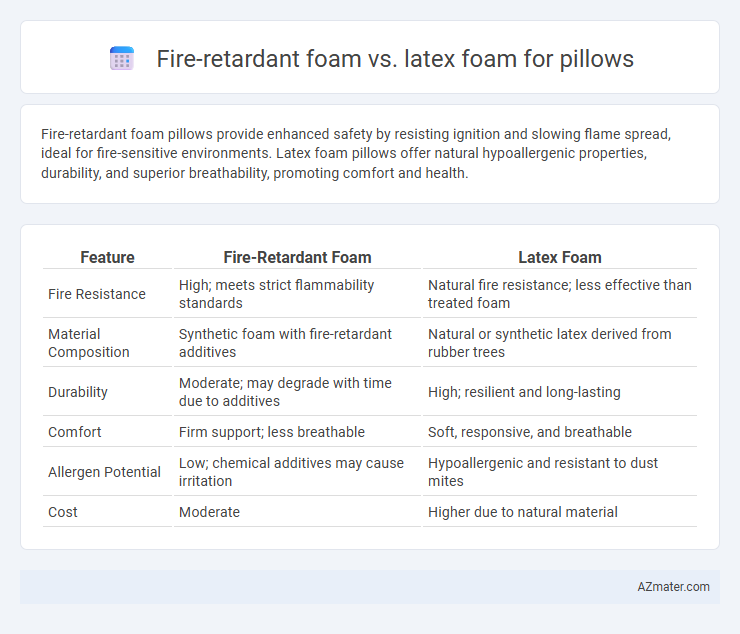Fire-retardant foam pillows provide enhanced safety by resisting ignition and slowing flame spread, ideal for fire-sensitive environments. Latex foam pillows offer natural hypoallergenic properties, durability, and superior breathability, promoting comfort and health.
Table of Comparison
| Feature | Fire-Retardant Foam | Latex Foam |
|---|---|---|
| Fire Resistance | High; meets strict flammability standards | Natural fire resistance; less effective than treated foam |
| Material Composition | Synthetic foam with fire-retardant additives | Natural or synthetic latex derived from rubber trees |
| Durability | Moderate; may degrade with time due to additives | High; resilient and long-lasting |
| Comfort | Firm support; less breathable | Soft, responsive, and breathable |
| Allergen Potential | Low; chemical additives may cause irritation | Hypoallergenic and resistant to dust mites |
| Cost | Moderate | Higher due to natural material |
Introduction to Pillow Foams
Fire-retardant foam and latex foam represent two distinct types of pillow materials with unique properties that impact comfort and safety. Fire-retardant foam is engineered to resist ignition and slow the spread of flames, meeting strict fire safety regulations commonly required in hotels and public accommodations. Latex foam offers natural breathability, durability, and hypoallergenic qualities, providing resilient support while minimizing allergens, making it a popular choice for health-conscious users seeking comfort and safety.
What Is Fire-Retardant Foam?
Fire-retardant foam is specifically engineered to resist ignition and slow the spread of flames, making it a safer choice for pillows in compliance with fire safety regulations such as California TB117-2013. Unlike latex foam, which is naturally derived from rubber tree sap and offers hypoallergenic and biodegradable properties, fire-retardant foam incorporates chemical additives or treatments designed to meet strict flammability standards. This foam is ideal for environments demanding higher safety measures without compromising comfort and durability.
Understanding Latex Foam
Latex foam, derived from natural or synthetic rubber, offers excellent breathability, durability, and hypoallergenic properties, making it a preferred choice for pillows compared to fire-retardant foam, which primarily focuses on flame resistance through chemical additives. Unlike fire-retardant foam that may contain potentially irritating flame retardants, latex foam provides a more natural and eco-friendly sleeping surface with resilience and pressure relief. Understanding latex foam involves recognizing its elasticity, moisture-wicking abilities, and resistance to dust mites, which contribute to improved sleep quality and comfort.
Safety Features: Fire-Retardant vs Latex Foam
Fire-retardant foam pillows provide enhanced safety by containing fire-resistant chemicals that significantly reduce flammability and slow the spread of flames, making them compliant with strict fire safety standards such as the TB117-2013. Latex foam pillows, while naturally resistant to dust mites and mold, lack inherent fire-retardant properties and typically require chemical treatment to meet fire safety regulations. Choosing fire-retardant foam ensures compliance with fire safety codes, whereas untreated latex foam prioritizes hypoallergenic benefits but may pose higher flammability risks.
Comfort and Support Comparison
Fire-retardant foam pillows provide enhanced safety through flame-resistant properties, while offering firm support that maintains spinal alignment. Latex foam pillows are known for their breathable, resilient structure that contours to the head and neck, delivering balanced pressure relief and comfort. When comparing comfort and support, latex foam excels in responsiveness and cooling, whereas fire-retardant foam prioritizes durability and safety without sacrificing essential support.
Durability and Longevity
Fire-retardant foam pillows offer enhanced durability due to their resistance to heat and flames, making them ideal for safety-conscious users, while latex foam pillows excel in longevity thanks to their natural resilience and ability to maintain shape over time. Latex foam resists sagging and indentation better than many fire-retardant foams, contributing to a longer lifespan in everyday use. Both materials provide durable support, but latex foam typically outperforms fire-retardant foam in maintaining structural integrity over extended periods.
Hypoallergenic Properties: Which Is Healthier?
Fire-retardant foam pillows often contain chemical treatments that can emit volatile organic compounds (VOCs), potentially triggering allergies or respiratory issues, whereas latex foam pillows are naturally hypoallergenic, resistant to dust mites, mold, and bacteria. Latex foam, especially organic or natural variants, offers a healthier option for allergy sufferers due to its antimicrobial properties without harmful chemicals. Choosing latex foam enhances indoor air quality and reduces exposure to allergens, making it the preferred choice for those prioritizing health and hypoallergenic comfort in pillows.
Environmental Impact and Sustainability
Fire-retardant foam often contains chemical additives like brominated flame retardants, which can release toxic compounds harmful to both human health and the environment during production and disposal. Latex foam, especially natural latex derived from rubber trees, offers a more sustainable option due to its biodegradability and renewable sourcing, reducing landfill waste and ecological footprint. Choosing latex foam pillows supports eco-friendly manufacturing practices and promotes healthier indoor air quality by avoiding synthetic chemicals.
Cost and Affordability Analysis
Fire-retardant foam pillows generally cost 20-30% more than latex foam due to specialized chemical treatments enhancing flame resistance. Latex foam pillows provide a more affordable option without compromising durability and natural hypoallergenic properties, often priced 15-25% lower than fire-retardant alternatives. For budget-conscious consumers prioritizing safety standards, fire-retardant foam is a valuable investment, while latex foam suits those seeking cost-effective comfort and breathability.
Choosing the Best Foam for Your Pillow
Fire-retardant foam offers enhanced safety by resisting ignition and slowing the spread of flames, making it ideal for individuals prioritizing fire safety in their bedding. Latex foam provides superior breathability, natural hypoallergenic properties, and excellent support, catering to those seeking comfort and eco-friendly materials. Choosing the best foam for your pillow involves balancing fire safety standards with comfort preferences, ensuring the material meets both regulatory requirements and personal sleep needs.

Infographic: Fire-retardant foam vs Latex foam for Pillow
 azmater.com
azmater.com